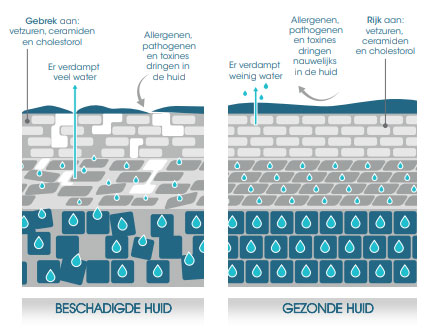Skin barrier repair in companion animals
The skin is the largest organ of the body and performs an important protective and regulatory function. In companion animals, the skin, along with the fur, covers up to 12% of the body weight. The outer layer, the epidermis, forms the first barrier between the body and the outside world. And it is precisely this barrier that deserves our attention.
What do we mean by the skin barrier?
The skin barrier consists of the upper layer of the epidermis and functions as a "wall. Dead horny cells act as the bricks and are held together by the body's own fats such as ceramides, cholesterol and free fatty acids - the "cement. This structure prevents excessive moisture loss and protects against external influences such as allergens, pathogens, irritants and temperature differences.
Once this balance is disturbed - for example, by washing, disease, age or environmental factors - the skin loses moisture and becomes more permeable to unwanted substances.


What undermines the skin barrier?
In animals with dry, scaly or sensitive skin, the "wall" is often weakened. Causes include:
- Deficiency of ceramides and fatty acids
- Excessive washing with harsh shampoos
- Age-related changes
- Irritants such as alcohol or perfume
The skin barrier is also often affected in conditions such as atopic dermatitis, parasitic infections or endocrine disorders. It is then essential in care not only to treat, but also to actively support.
Support with the right ingredients
An effective approach begins by restoring hydration as well as replenishing the lipid layer. Hydrating ingredients such as hyaluronic acid, glycerin, urea and propylene glycol attract and retain moisture in the skin. Ceramides and fatty acids supplement the "cement" of the skin barrier and help the skin restore its protective function.
Here, pay attention to the composition of personal care products. Avoid ingredients such as harsh soaps, alcohol or synthetic fragrances, especially with affected or sensitive skin. Rather, choose products with active, skin-identical substances that actually contribute to recovery.
Practical applications for veterinarians
Supporting the skin barrier does not have to be complex. Consider:
- Shampoo with a mild, skin-friendly formula
- Mousse or spray with moisturizing and barrier-fixing ingredients for topical use
- Creams for targeted application to dry, damaged or fragile skin areas
Maxani AtopOat is a line specifically designed to support the skin barrier. These products include ceramides, hyaluronic acid and oatmeal extract. They are available in three forms: a skin shampoo, a mousse and a cream - so there is an appropriate application for every case.
Conclusion
An intact skin barrier is a prerequisite for skin health. By paying attention in the clinic to supportive care - in addition to medical treatment - you contribute to faster recovery, less recurrence and more comfort for the animal. The right products can make a big difference, especially in animals with sensitive or affected skin.
